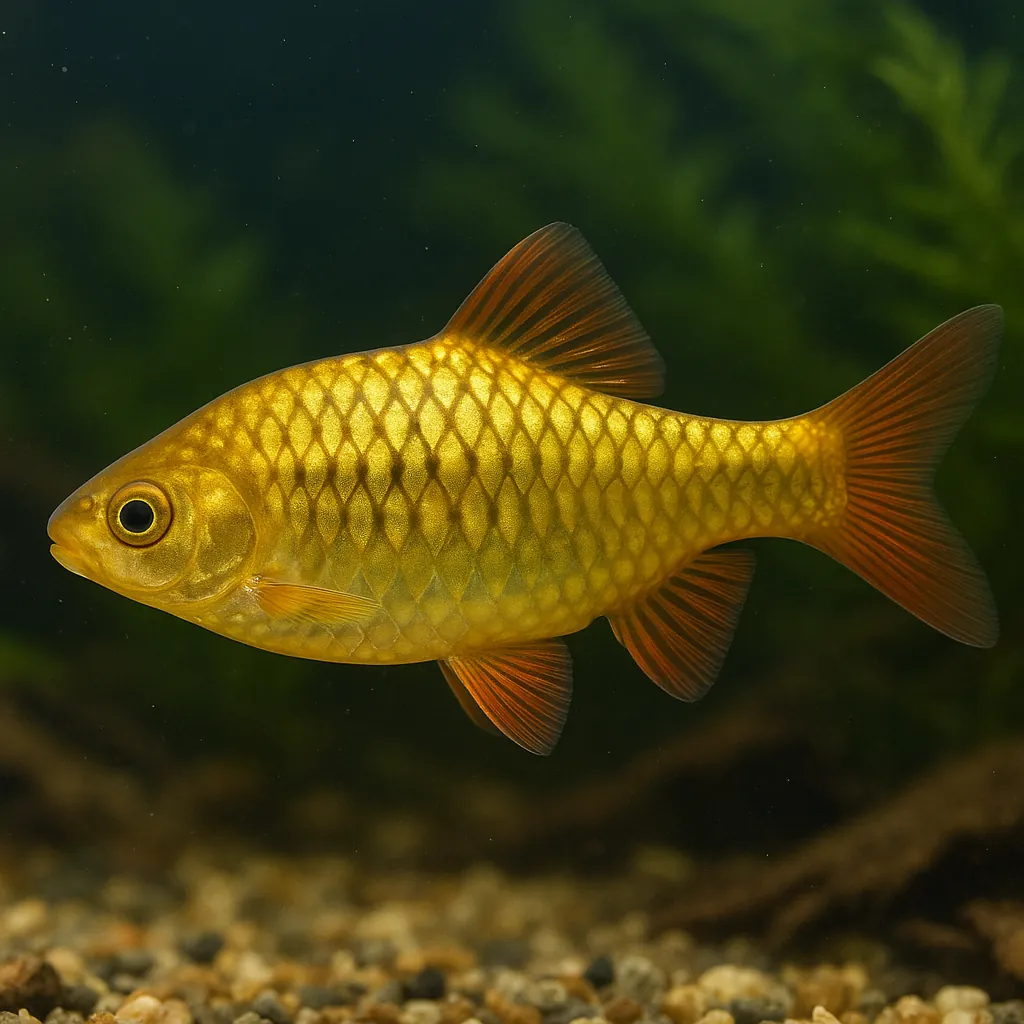
Gold barb
Introduction
The Gold Barb, scientifically known as Pethia gelius, is a vibrant and active freshwater fish that has become a favorite among aquarists. Its striking golden coloration and peaceful nature make it an excellent choice for community tanks. Renowned for its hardiness and ease of care, the Gold Barb is well-suited for both novice and intermediate fishkeepers.
What makes the Gold Barb a popular choice for aquariums?
Its bright golden hue and lively behavior add visual appeal and energy to any tank, while its adaptability to various water conditions simplifies maintenance for aquarists.
Is the Gold Barb suitable for beginners?
Yes, due to its hardy nature and straightforward care requirements, the Gold Barb is ideal for those new to fishkeeping.
Care and Environment
Providing optimal care for the Gold Barb involves understanding its habitat needs and ensuring a well-maintained environment.
What is the minimum tank size for a Gold Barb?
A minimum tank size of 75 liters (20 gallons) is recommended to accommodate a small school of Gold Barbs, allowing ample space for swimming and social interactions.
What are the ideal water parameters for Gold Barbs?
Gold Barbs thrive in water temperatures between 20°C and 26°C (68°F to 79°F), with a pH range of 6.0 to 7.5, and water hardness between 4 to 10 dGH.
Maintaining clean water is crucial. A gentle filtration system is recommended, as Gold Barbs prefer calm water. Regular water changes of about 20% weekly help maintain water quality.
In terms of diet, Gold Barbs are omnivorous and benefit from a varied diet. High-quality tropical fish flakes or pellets should form the staple, supplemented with live or frozen foods like brine shrimp, bloodworms, and daphnia. Occasional offerings of plant-based foods, such as spirulina flakes or blanched vegetables, ensure a balanced diet. Feed them 2-3 times daily, providing only as much food as they can consume in a few minutes to avoid overfeeding.
For tank decor, a soft, sandy substrate is suitable. They appreciate a well-planted tank with plenty of hiding spots, as plants and decorations help create a sense of security. Live plants such as Java fern, Anubias, and Amazon swords are good options. Adding driftwood and rocks can provide additional hiding spots. Moderate lighting enhances their golden coloration, and floating plants can help diffuse the light and create shaded areas that reduce stress.
Are there any specific challenges in keeping Gold Barbs?
While generally hardy, Gold Barbs can exhibit fin-nipping behavior if not kept in adequate group sizes. Ensuring a group of at least 6 individuals can mitigate this tendency.
Origin and Habitat
Gold Barbs are native to the freshwater rivers and streams of Southeast Asia, particularly in regions of China, Vietnam, and Thailand. They inhabit sub-tropical rivers, often found in the Red River Basin.
What type of environments do Gold Barbs naturally inhabit?
They are typically found in sub-tropical rivers with high oxygen levels and moderate mineral content, often in areas with a gentle current and abundant vegetation.
How does their natural habitat influence their care in aquariums?
Replicating their natural environment by providing well-oxygenated water, moderate flow, and plenty of plants helps ensure their health and well-being in captivity.
Temperament and Compatibility
Gold Barbs are peaceful and social fish, making them excellent candidates for community aquariums.
Do Gold Barbs need to be kept in groups?
Yes, they are schooling fish and should be kept in groups of at least 6 to encourage natural behaviors and reduce stress.
What are suitable tank mates for Gold Barbs?
Compatible tank mates include other peaceful species such as Harlequin Rasboras, Zebra Danios, Cherry Barbs, Platies, Corydoras Catfish, and Pearl Gouramis.
It's advisable to avoid housing them with slow-moving or long-finned fish, such as Angelfish or Betta fish, as Gold Barbs may nip their fins, especially if not kept in large enough groups.
Interesting Facts
Gold Barbs have a fascinating history and unique traits that add to their appeal.
How did the Gold Barb become popular in the aquarium trade?
The popular gold strain, known as the Schuberti barb, was developed by hobbyist Thomas Schubert in the 1960s through selective breeding.
Do Gold Barbs exhibit any unique behaviors?
They are known for their active swimming and can be excellent jumpers, so it's important to keep the aquarium well-covered to prevent escapes.
What is their typical lifespan in captivity?
With proper care, Gold Barbs can live between 4 to 6 years, providing aquarists with years of enjoyment.
Sources
All information in this article has been gathered from the following reputable sources:
Overview
Recommended Tank Size 26.4 Gallons (for groups of 6 or more) |
Minimum Group Size 6 |
Minimum Tank Volume 19.8 Gallons |
Maximum Adult Length 2.8 inches |
Average Adult Length 2 inches |
Shoaling (6+ required) Yes |
Preferred Water Type Freshwater, soft to moderately hard, slightly acidic to neutral |
Temperature Range (°C) 20–26 |
pH Range 6.0–7.5 |
Water Hardness (dGH) 4–10 |
Typical Lifespan (years) 4 years |